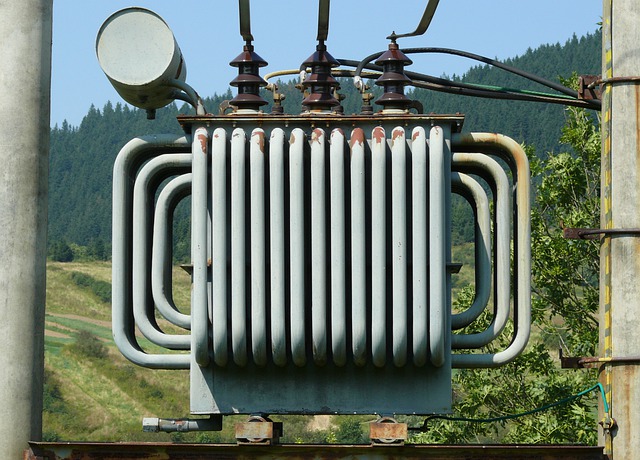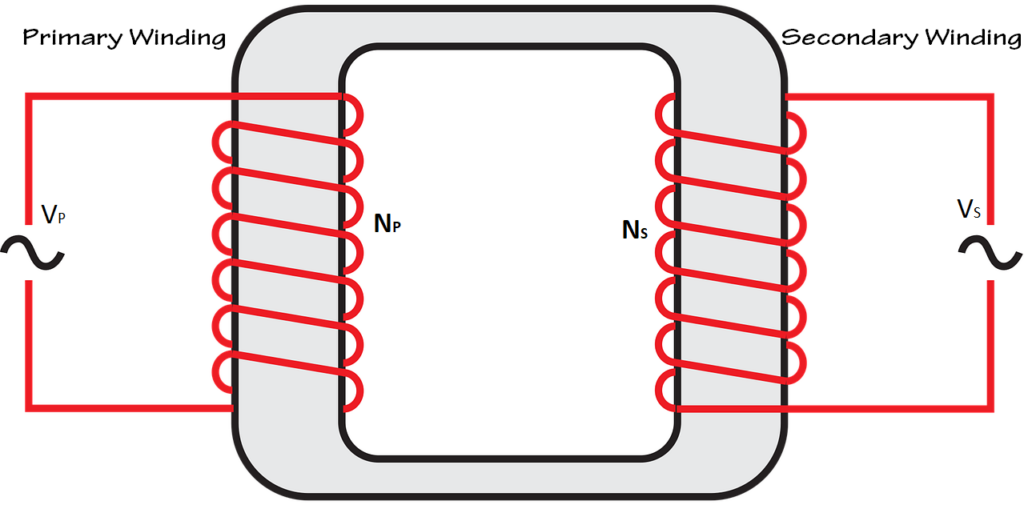Transformers
Key Points:
- Transformers allow us to increase and decrease the voltage of an AC signal with ease and reliability.
- A basic transformer consists of two coils of wire wound around a core of iron.
- The input coil is called the primary winding and the output coil is called the secondary winding.
- The transformer produces an output voltage at the secondary windings (VS) is determined by the voltage across the primary windings (VP) times the number of turns on the primary (NP) and secondary (NS) windings:
V_S = V_P\frac{N_S}{N_P}
Why it Matters:
High voltage is needed to reduce losses during power transmission, and low voltages are needed at home for safety. Within circuits, a higher or lower voltage might be needed for any given application.
How do we transform one voltage input to a different voltage output?
The answer is the AC transformer. Transformers use the principle of induction to convert an AC electrical signal with any voltage, into one with a higher or lower voltage. It works so well that even simple transformers have relatively minimal losses. In fact, transformers are so effective that they resulted in the widespread adoption of AC (rather than DC) as the choice of power across the globe.
Due to their simplicity and effectiveness, transformers revolutionized the electrical power industry, leading to the widespread use of electricity and much of the technology we treasure today.
What are Transformers?
Transformers are simply devices that allow us to take one input AC voltage and transform it into a different voltage.
A simple transformer consists of two coils of wire wound around an iron core. The input side/coil of the transformer is called the primary winding, and has NP number of turns. The output side/coil of the transformer is called the secondary winding, and has NS number of turns.
The transformer produces a voltage VS across the secondary winding.

The output voltage VS depends on:
1) The input voltage VP, and
2) The ratio between the number of turns on the second and first coil (NS/NP):
V_S = V_P\frac{N_S}{N_P}A transformer’s output is adjusted by changing the number of turns on the primary or secondary windings.
To increase the voltage, we need to increase the number of turns on the secondary windings or decrease the number of turns on the primary windings.
To decrease the voltage, we need to increase the number of turns on the secondary windings or decrease the number of turns on the primary windings.
This is how a transformer looks in an electrical schematic, with a load of impedance ZS across the secondary winding:

How Transformers Work
Transformers operate on the principle of electromagnetic induction.
Electricity is not conducted from one side of the transformer to the other.
Instead, a magnetic field is formed in the iron core by the first set of windings. Just as with inductors, an iron core is used to confine and intensify the magnetic field. This magnetic field then induces a voltage across the secondary windings. This second voltage, almost miraculously, depends on the ratio of turns on the primary and secondary windings.
Transformers: Back to Back Inductors?
Recall that inductors frequently use an iron core to confine and intensify the magnetic field generated by the coil. Transformers also use an iron core, but (unlike inductors) transformers have two separate, insulated coils wrapped around a single piece of iron. The iron confines the magnetic field and greatly increases the efficiency of energy transfer between the primary and secondary windings.
Transformers operate on the same principle as inductors. Inductors produce a back EMF that opposes the current in the circuit. In a transformer, the magnetic field that is formed is used to generate a voltage across the secondary winding.
Transformers are so similar to inductors, in fact, that they can be thought of as two inductors wound around a single piece of iron. The input inductor (primary winding) converts electrical energy into a magnetic field, which is ‘trapped’ by the iron core. In an ordinary inductor, this magnetic field would either remain unchanging (if a DC current is applied), or would oppose any change in current (if an AC current is applied). In a transformer, however, the second set of coils provides a path for the magnetic field to induce an output voltage. The resulting voltage does not oppose current (as with an inductor in an AC circuit), but is instead generated in the secondary windings.
Transformers are known as either step-up or step-down depending on whether they increase or decrease the input voltage. Step-up transformers increase the input voltage (V2 > V1) . Step-down transformers decrease the input voltage (V1 >V2).
Transformers Change Current, Too
Even though transformers change the voltage of the input signal, an ideal transformer will conserve the total power of the signal.
In other words, transformers don’t create or destroy energy. When a signal’s voltage is increased, the current must decrease so that total power is conserved.
Recall that power is equal to the voltage times the current:
P = IV
What we mean by conservation of power, is that the power at the primary winding (PP) must equal the power at the secondary winding (PS):
P_P = P_S = I_PV_P = I_SV_S
Any change in voltage therefore produces a corresponding change to the current. Increasing the voltage will decrease the current, and decreasing the voltage will increase the current. We can find the output current by solving for IS in the equation above:
I_S =\frac{I_PV_P}{V_S}This feature allows the transformer to be used not only to change the voltage, but the current as well.
Step Up Transformers
Step-up transformers increase the voltage of the signal (VS > VP). They are used intensively in power transmission in order to increase voltage after generation.
Why is this necessary?
All conductors (with the exception of superconductors) have at least a little bit of electrical resistance. This means that as electrons flow through the conductor, they bump into things like atoms along the way- generating heat. This is known as Joule heating. When it comes to resistors, Joule heating is desired because it allows us to control electric current. We can often disregard Joule heating in conductors in many circuits, especially where the conductive paths are not very long.
But when we need to conduct electricity over a long distance, Joule heating can be a huge source of energy loss.
When Thomas Edison was marketing his DC systems, Joule heating was the main issue he could not overcome. To understand why, let’s look at the Joule-Lenz law, which states that power loss is proportional to the resistance times the square of the current. This is also commonly known as ‘I-squared R’ losses:
P_{loss} \propto I^2RSo if we can reduce the current, we can significantly reduce Joule heating losses.
The transformer provides the perfect solution: decrease the current by increasing the voltage.
That’s why we use step-up transformers to increase the voltage to very high levels before transmission.
For Edison, there was only one (big) problem: transformers don’t work with DC systems. Edison fervently believed that DC was superior to AC, and refused to accept that this limitation would probe insurmountable. His DC systems worked well at small scale. But if power needed to be transmitted even a short distance, the losses were so great that AC soon overshadowed DC. Eventually, even his own company embraced AC technology, but his battle with rival George Westinghouse had been lost.
In the battle between DC and AC systems in power generation and transmission, AC came out the clear victor. Thanks to transformers.
Step Down Transformers
Step-down transformers are used to decrease the voltage, such as following transmission.
Lower voltage is safer to work with, and digital electronics don’t require a high voltage to function. So before electrical power is supplied to a home or business, the voltage is decreased to a safer level using step-down transformers.